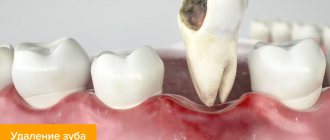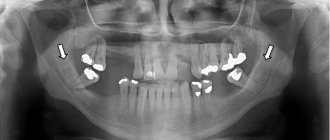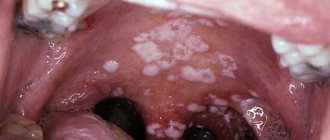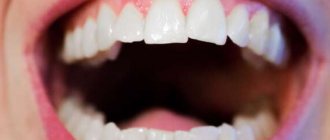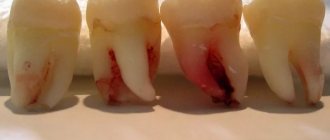Tooth extraction is a process that traumatizes the gums. After healing a diseased tooth, nerves, ligaments and small blood vessels are torn, which causes bleeding. This is a natural process - the blood does not allow pathogenic organisms to enter the circulatory system, washing them out. And then, curled up, it forms a barrier between unprotected tissues and bacteria. After tooth extraction, white plaque on the gum is not pus, but another stage of protection and restoration of the body.
When removing a tooth, the patient must be prepared:
➢
to moderate bleeding that may last for some time;
➢
the appearance of a dense blood clot in the gum;
➢
unpleasant odor 10-12 hours after surgery;
➢
the formation of a white coating on the blood clot;
➢
pain after surgery;
➢
temperature rise.
The listed symptoms are not a sign of an unsuccessful operation or infection in the body - this is the body’s natural response to tooth extraction.
What is white plaque on the wound after tooth extraction?
A few hours after the tooth is removed, a dark clot appears in the socket - bluish, black, red or brown. This clot is blood, and it is the primary protection of the socket from bacteria or pieces of food entering it. On the 2nd - 4th day, the patient may see that a coating appears on the clot - yellowish, gray or white. The deposit looks like pus and, together with the resulting bad breath, can alert the patient. However, there is no need to be alarmed - this plaque is not a sign of wound decay and indicates a normal healing process. This special protein compound is fibrin.
A milky plaque (fibrinous) can be very dense, hard or soft. This is no cause for concern. If you come to the dentist with this question for an unscheduled appointment, the specialist will tell you that everything is in order and there is no need to remove the film.
If the film is not removed and the wound is not disturbed, active processes will occur underneath it:
- the blood clot will begin to dissolve;
- the hole will begin to decrease in size;
- young cells, osteoblasts, will begin to move from the edge of the wound to the center;
- The gums will begin to close the wound.
Fibrinous plaque after tooth extraction is a natural stage of gradual recovery of the body, in which it is better not to interfere.
Lump on gum after tooth extraction
We would like to immediately warn you that sometimes complications after tooth extraction occur, no matter what. And it is not always the doctor or the patient himself who is to blame for complications. Although, undoubtedly, the high qualifications and experience of the doctor minimize the risk associated with complications.
If a lump forms on the gum after tooth extraction, this symptom may indicate the presence of inflammation. If the blood clot that usually forms in the hole somehow comes off or does not form at all due to frequent rinsing, then harmful bacteria can enter the wound and cause inflammation. Pieces of food that get into the wound can also inflame the gums. Therefore, dentists usually do not recommend that patients eat in the first few hours after extraction, until the bleeding stops and a blood clot forms.
If you have a lump on your gum after surgery, you should immediately see a dentist, since the inflammatory process requires immediate treatment. Before visiting a doctor, you should never warm the cheek on the side on which the abscess forms, since heat only intensifies the inflammation, making it more intense and fleeting. Cold will help relieve symptoms - you can apply ice cubes to your cheek, previously placed in a plastic bag.
You can’t try to remove a lump on your own! And that's why:
- firstly, only a doctor can correctly diagnose, and what seemed like a lump to you after tooth extraction may actually turn out to be another neoplasm;
- secondly, by removing the lump yourself, you can reinfect the wound, thereby provoking an even more acute inflammatory process!
After a careful examination of the oral cavity, the doctor will make a final conclusion about the causes. If the cause of its formation is an infection introduced into the wound and, as a consequence, an inflammatory process, then treatment will consist of anti-inflammatory therapy. First of all, the doctor will open the resulting lump to release the pus that has accumulated in it. Then rinse the gums with an antiseptic solution to prevent the lesion from spreading. After this, the doctor may also prescribe antibiotics to stop the development of the disease. As an auxiliary therapy, the doctor will recommend rinsing the mouth with antiseptic solutions, as well as decoctions of medicinal herbs.
It should be noted that the occurrence of inflammatory processes and lumps on the gums after tooth extraction occurs, as a rule, in those who have reduced immunity due to a previous disease. Therefore, in parallel with treatment, the doctor will definitely recommend that the patient take multivitamin complexes in order to strengthen the immune system and support a weakened body. It is necessary to follow all the doctor’s recommendations, since only their strict implementation guarantees a quick recovery.
Why you don’t need to remove white plaque after tooth extraction
In some cases, patients intentionally or accidentally remove a blood clot or fibrinous film from the socket. This is not necessary, since removing a clot or film can provoke negative processes.
First of all, an open wound provides access for bacteria to the circulatory system and tissues of the maxillofacial apparatus. Infection can cause serious consequences and require long-term treatment with antibiotics. Also, removing the clot and white plaque increases the pain, since an open wound is more sensitive to any irritants, including drinking drinks and food, during a conversation.
Finally, plaque on the gums after tooth extraction does not need to be cleaned off because this can cause re-bleeding and prolong the wound healing stage.
In any case, there is no need to intentionally remove plaque; this can cause:
- serious complications;
- severe pain;
- improper gum formation;
- long recovery process after tooth extraction.
To avoid accidentally damaging the socket, blood clot or fibrinous film, you must follow the recommendations given by the doctor after the operation.
Causes
The formation of a cyst on the gum after tooth extraction is caused by:
- tissue damage during surgery,
- using a non-sterile instrument,
- disruption of the wound healing process.
The most common cause of pathology is the patient’s failure to comply with medical recommendations. Frequent rinsing of the mouth after tooth extraction, refusal to take antibacterial drugs, poor oral hygiene are risk factors for wound infection. With the active proliferation of pathogenic microorganisms, an inflammatory process quickly develops and a cyst with purulent contents is formed.
How not to damage white plaque after wisdom tooth removal
To eliminate the risk of complications and speed up the recovery process, you need to follow the rules of behavior after tooth extraction:
- do not eat or drink for 3 hours after surgery;
- stop smoking and drinking alcohol for a while;
- do not heat the cheek and gums, avoid overheating;
- for the first 24 hours, do not rinse your mouth or brush your teeth;
- Do not go to the bathhouse for a week, do not play sports.
Smoking is contraindicated, as it provokes vasospasm: the bleeding stops too quickly, the blood clot is not formed enough. Hot drinks, warming the cheek, sports training and visiting a bathhouse cause overheating of the body and dilation of blood vessels, which can cause re-bleeding, opening and infection of the wound.
Rinsing and brushing the mouth are acceptable 24 hours after tooth extraction, but they should not be overly vigorous. Hygienic procedures must be moderate so that the blood clot remains in the cavity and the subsequently formed fibrinous protective layer is not damaged. During the recovery period, food should be chewed only on the non-operated side of the jaw.
If you have a fever and severe pain in the first few days after tooth extraction, you can take Paracetamol - this will help reduce discomfort and improve your well-being.
When white plaque on a wound after tooth extraction requires examination by a doctor
Despite the fact that white plaque after wisdom tooth removal is a natural reaction, the patient needs to conduct a daily self-examination of the oral cavity and consult a doctor for help if alarming symptoms appear.
You should consult a doctor if:
➢
on the 3rd - 4th day the pain does not decrease, it becomes throbbing and intense;
➢
a white, reddish or yellow mass or liquid is released from the wound;
➢
swelling of the gums has intensified or spread to the face;
➢
body temperature rose above 38 degrees.
These signs indicate possible infection or complications. After examining the oral cavity, the dentist, if necessary, may prescribe a course of antibiotics or surgical cleaning of the socket cavity.
Lump in the cheek after wisdom tooth extraction
However, patients may complain that the cheek is swollen, there is pain when touched, and the gums have a bluish tint.
Each case is individual. The most likely causes of the pathology are:
- Inflamed lymph node (lymphadenitis) after wisdom tooth extraction. It is characterized by local soreness, tightness in the cheek, and general malaise. Gradually the knot will shrink and become less of a concern. If this does not happen, it is important to consult a doctor.
- Hematoma. Accompanied by cyanosis, it goes away on its own within a few days. Sometimes there is pain, swelling, and fever. In such a situation, the surgeon makes an incision in the gum, washes the wound with antiseptic drugs, and installs drainage to drain the exudate. At the same time, antibacterial drugs and antiseptic rinses are prescribed. If left untreated, a hematoma can provoke phlegmon and an abscess.
- Periostitis (flux). A white ball on the gum filled with pus. Occurs if, after the removal of a wisdom tooth, the wound becomes infected. Microorganisms quickly reached the periosteum and caused an inflammatory process. Symptoms of flux: fever, sharp pain in the area of the extracted tooth, the appearance of a white ball on the gum. Urgent dental care is required to avoid rupture of the purulent sac and infection in the blood.
Gum healing
After tooth extraction, you need to be prepared for the fact that pain and swelling may intensify on the second day after surgery. But already on the 3rd - 4th day after the operation, the discomfort will begin to decrease. By this time, the wound healing processes are more active, and by touching the tip of the tongue to the hole, you can feel that a compaction has formed.
During this period, the following are actively developing:
- bone formation in the area of the removed tooth root;
- narrowing of the socket due to the “growth” of the gums;
- formation of the mucous membrane in the socket area.
Fibrinous plaque after tooth extraction persists for a week. It disappears on its own, without mechanical cleaning. Little by little, the mucous membrane begins to turn pink, gradually acquiring a healthy, natural color. Around the 10th day, wound healing is completed: healthy tissue is formed that covers the mouth of the hole. A small depression remains in the area of the removed tooth. The formation of bone tissue at the site of tooth extraction takes much longer - up to 6 months. Changes will be visible on an x-ray.
Symptoms
For a long time, a cyst on the gum, formed after tooth extraction, may not manifest itself in any way. The inflammatory process may also be accompanied by:
- a feeling of heaviness and bursting at the site of tooth extraction,
- swelling of tissues,
- aching pain in the jaw,
- discomfort while eating,
- temperature rise,
- weakness, increased fatigue and other signs of intoxication of the body.
These symptoms cannot be ignored. At the first signs of inflammation after tooth extraction, you should immediately contact a dental clinic. Timely treatment will avoid serious complications - abscess, phlegmon, osteomyelitis, sepsis.

